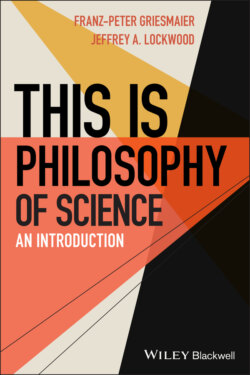Читать книгу This is Philosophy of Science - Franz-Peter Griesmaier - Страница 24
2 EVIDENCE, OBSERVATION, AND MEASUREMENT 2.1 The Promises of Evidence
ОглавлениеWhat’s so great about evidence? Science is often regarded as the paradigmatically rational way to gain knowledge about the natural world. In particular, it has been argued that in contrast to ideology, religion, and mysticism, science is both appropriately responsive to how the world actually is and allows for a rational resolution of disputes between different theories about the world. Both of these features of science are intimately tied to its use of evidence. Evidence, at least ideally, is publicly accessible, sharable, and can serve as an arbiter in the competition between different theories. In other words, in contrast to disputes between different religious beliefs, political worldviews or economic ideologies, which typically cannot be resolved by appealing to a neutral standard, science solves such disputes in a rational manner, because it has access to a neutral standard: evidence.
Let’s look at this in more detail. Generally speaking, evidence typically indicates (although we’ll see important exceptions) particular facts about the world. Tracks in the snow, for example, may indicate the prior presence of a mule deer, and those tracks are thereby evidence for the mule deer’s earlier presence in the area. How do those tracks provide evidence for that fact? The answer is straightforward: The deer caused the tracks that you are seeing in the snow. This means that at least this one form of evidence is grounded in causal relations between different features of the world. In our case, the causal relation was one between the deer’s hoofs and the tracks. And there are numerous similar cases: The victim’s blood on John’s shirt is evidence for the hypothesis that John was at the murder scene, because the injuries of the victim caused her blood to end up on John’s shirt. The so-called Koplik spots on a person’s gums are evidence for the hypothesis (often called a diagnosis in this context) that the person has the measles, because having the measles causes those spots to appear. In fact, there are so many cases in which we have observable indicators (i.e., evidence) for features of the world we might not directly observe (deer, measles, etc.) that one might be tempted to simply define evidence in terms of a causal indicator relation, maybe along the following lines:
An observable feature O of the world is evidence for the existence of an unobserved or unobservable feature U of the world if and only if U caused O, and O thereby indicates the existence of U.
A brief remark on the distinction between unobserved and unobservable features, invoked above, is in order. In our first example, the deer was simply unobserved, but is of course observable. But there also seem to be clear cases where we can’t observe that for which we might have observable evidence. Newtonian gravitation is a good example. We can observe its effects when we see a football drop into the outstretched arms of the receiver. However, we can’t observe the gravitational force directly. In fact, it seems we can’t observe any of the fundamental forces of nature directly. For this reason, many have argued that forces are prime examples of entities that are in principle unobservable, and that the only reason we have for believing that they exist at all is the evidence manifest in their actions. We can see neither the strong nor the weak nuclear force, but we can see their effects, the most prominent of which are of course all those familiar physical objects that surround us.1 This is the reason that the proposed analysis of the notion of evidence refers to both unobserved and unobservable features.
Let’s go back now to the idea that evidence can be defined in terms of causal relations between different features of the world. If this idea is correct, it would also explain nicely why scientific disputes can be resolved by appealing to a neutral, objective standard, as we claimed earlier. At first glance, it seems that causal relations are objective features of the world. Their existence is independent from human observers – the extinction of the dinosaurs was caused by certain features of the world (most likely by a meteor that hit the earth), even though there were no humans to observe it. Thus, what humans believe has no influence on the causal relations that exist in the world. This explains how evidence can help us decide between competing theories: Since two genuinely differen theories will not agree on all possible evidence, then, if we find evidence that can be better accounted for by Jane’s theory than by Bob’s, we have objective reasons for deciding the competition in favor of Jane. The reasons are objective, because causal relations that ground evidential relations are objective. Thus, if Bob holds on to his theory despite the evidence favoring Jane’s, he acts unreasonably.
This last observation leads to a further important fact concerning our ordinary concept of evidence. We think that our beliefs about the world have to be properly responsive to empirical evidence, and if they are not, those beliefs appear irrational. Thus, there is an important connection between being rational and being responsive to evidence. This connection will be the topic of later chapters. For now, our next task is to discuss what items in the “world” are appropriate candidates for evidence.
